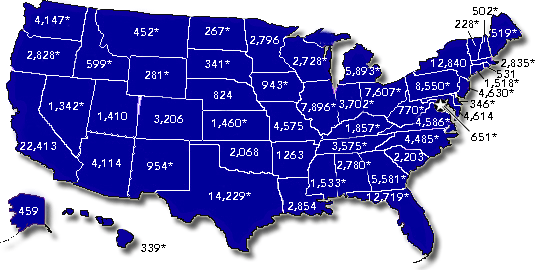Overview
TBIs contribute to a substantial number of deaths and cases of permanent disability annually. CDC estimates that at least 5.3 million Americans, about 2% of the U.S. population, currently have a long-term or lifelong need for help to perform activities of daily living as a result of a TBI.1
The severity of a TBI may range from “mild,” i.e., a brief change in mental status or consciousness to “severe,” i.e., an extended period of unconsciousness or amnesia after the injury. Approximately 75% of TBIs that occur each year are concussions or other forms of mild TBI.2
Recent data shows that, on average, approximately 1.4 million people sustain a TBI each year in the United States. Of those:
- 50,000 die;
- 235,000 are hospitalized; and
-
1.1 million are treated and released from an emergency department.3
Among children ages 0 to 14 years, TBI results in an estimated
- 2,685 deaths;
- 37,000 hospitalizations; and
-
435,000 emergency department visits.3
The number of people with TBI who are not seen in an emergency department or who receive no care is unknown.
Groups at Risk
- Males are about twice as likely as females to sustain a TBI.3
- The two age groups at highest risk for TBI are 0 to 4 year olds and 15 to 19 year olds.3
- Adults age 75 years or older have the highest rates of TBI-related hospitalization and death.3
- Certain military duties (e.g., paratrooper) increase the risk of sustaining a TBI.4
- African Americans have the highest death rate from TBI.3
- TBI hospitalization rates are highest among African Americans and American Indians/Alaska Natives (AI/AN).5
TBI Surveillance
CDC conducts surveillance to examine the impact of TBI in the United States by routinely analyzing national data from the National Center for Health Statistics and state grantees regarding: 1) TBI deaths; 2) hospital discharges; and 3) emergency department visits.6
CDC currently funds 30 states to conduct basic TBI surveillance through the Public Health Injury Surveillance and Prevention Program.
Numbers of TBI Cases in Each State
Please see the map below for information on nonfatal TBI specific to your state.
For more information on TBI-related hospitalizations and deaths in individual states, see State Injury Indicators Report. (Note: not all states participate in the voluntary submission of TBI- and other injury-related data compiled in this report.)
Number of nonfatal TBI hospitalization cases in 1998, on map and listed by state.7

State |
Cases |
State |
Cases |
| AK | 459 | MT | *452 |
| AL | *2,780 | NC | *4,485 |
| AR | 1,263 | ND | *267 |
| AZ | 4,114 | NE | 824 |
| CA | 22,413 | NH | *502 |
| CO | 3,206 | NJ | *4,630 |
| CT | *1,518 | NM | *954 |
| DC | *651 | NV | *1,342 |
| DE | *346 | NY | 12,840 |
| FL | *12,719 | OH | *7,607 |
| GA | *5,581 | OK | 2,068 |
| HI | *339 | OR | *2,828 |
| IA | *943 | PA | *8,550 |
| ID | *599 | RI | 531 |
| IL | *7,896 | SC | 2,203 |
| IN | *3,702 | SD | *341 |
| KS | *1,460 | TN | *3,575 |
| KY | *1,857 | TX | *14,229 |
| LA | 2,854 | UT | 1,410 |
| MA | *2,835 | VA | *4,586 |
| MD | 4,614 | VT | *228 |
| ME | *519 | WA | *4,147 |
| MI | *5,893 | WI | *2,728 |
| MN | 2,796 | WV | *770 |
| MO | 4,575 | WY | *281 |
| MS | *1,533 |
|
References
1. Thurman D, Alverson C, Dunn K, Guerrero J, Sniezek J. Traumatic brain injury in the United States: a public health perspective. Journal of Head Trauma Rehabilitation 1999;14(6):602–15.
2. Centers for Disease Control and Prevention (CDC), National Center for Injury Prevention and Control. Report to Congress on mild traumatic brain injury in the United States: steps to prevent a serious public health problem. Atlanta (GA): Centers for Disease Control and Prevention; 2003.
3. Langlois JA, Rutland-Brown W, Thomas KE. Traumatic brain injury in the United States: emergency department visits, hospitalizations, and deaths. Atlanta (GA): Centers for Disease Control and Prevention, Nation Center for Injury Prevention and Control; 2004.
4. Ivins BJ, Schwab K, Warden D, Harvey S, Hoilien M, Powell J, et al. Traumatic brain injury in U.S. army paratroopers: prevalence and character. Journal of Trauma Injury, Infection and Critical Care 2003;55(4):617–21.
5. Langlois JA, Kegler SR, Butler JA, et al. Traumatic brain injury-related hospital discharges: results from a fourteen state surveillance system, 1997. Morbidity and Mortality Weekly Reports 2003;52,SS-04:1–18.
6. Langlois J, Marr A, Mitchko J, Johnson R. Tracking the silent epidemic and educating the public: CDC’s traumatic brain injury-associated activities under the TBI Act of 1996 and the Children’s Health Act of 2000. Journal of Head Trauma Rehabilitation 2005;20(3):196–204.
7. Kegler S, Coronado V, Annest J, Thurman D. Estimating nonfatal traumatic brain injury hospitalizations using an urban/rural index. Journal of Head Trauma Rehabilitation 2003 Nov–Dec;18(6):469–78.
Contact Us:
- Centers for Disease Control and Prevention
National Center for Injury Prevention and Control (NCIPC)
4770 Buford Hwy, NE
MS F-63
Atlanta, GA 30341-3717 - 800-CDC-INFO
(800-232-4636)
TTY: (888) 232-6348
24 Hours/Every Day - cdcinfo@cdc.gov

